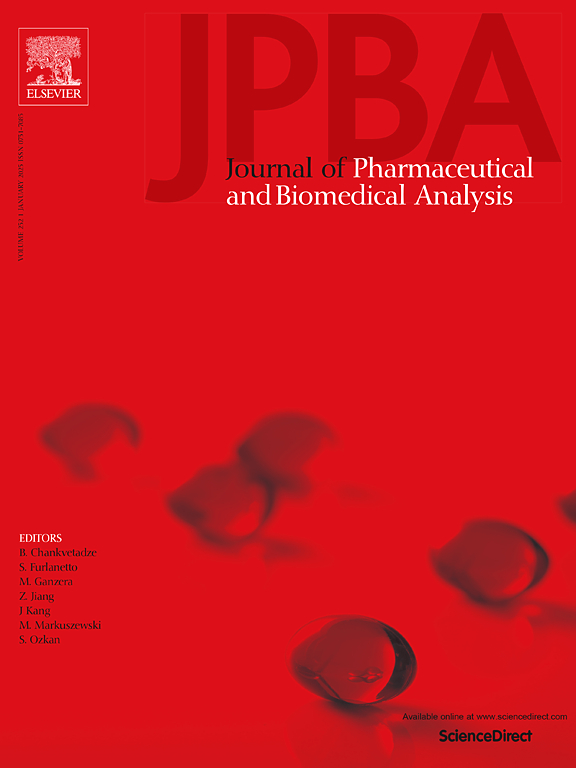Surrogate matrix approach to quantify endogenous progesterone in a fasting bioequivalence study of soft gelatin capsules in postmenopausal women
IF 3.1
3区 医学
Q2 CHEMISTRY, ANALYTICAL
Journal of pharmaceutical and biomedical analysis
Pub Date : 2025-05-12
DOI:10.1016/j.jpba.2025.116960
引用次数: 0
Abstract
In the present study, endogenous progesterone in plasma was quantified using a validated LC–MS/MS method. This bioanalytical technique was successfully applied to a bioequivalence study in postmenopausal female volunteers. The assay achieved a lower limit of quantification (LLOQ) of 20 pg/mL for endogenous progesterone. Electrospray ionization in positive mode was coupled to a triple-quadrupole mass spectrometer, with deuterated progesterone (progesterone-D9) as the internal standard. Chromatographic separation was performed on a Kinetex Biphenyl column (100 × 4.6 mm, 5 μm) using a time- and flow-gradient program to ensure symmetrical peak shapes and complete resolution from potential interferences. Progesterone was extracted from plasma using methyl tert-butyl ether, affording high recovery and negligible matrix effects. Quantitation was carried out in multiple-reaction monitoring (MRM) mode, monitoring the transitions m/z 315.5 → 97.2 for progesterone and m/z 324.3 → 113.1 for progesterone-D9. The calibration curve was linear over the range of 20.0–40 000.0 pg/mL and was fitted by weighted (1/x²) linear regression. The method fully complies with current regulatory guidelines for bioanalytical assay validation.
在绝经后妇女软性明胶胶囊的空腹生物等效性研究中,替代基质法定量内源性孕酮
本研究采用经验证的LC-MS /MS方法对血浆中内源性孕酮进行定量分析。该生物分析技术已成功应用于绝经后女性志愿者的生物等效性研究。内源性孕酮的定量下限(LLOQ)为20 pg/mL。以氘化孕酮(孕酮- d9)为内标,正模式电喷雾电离耦合至三重四极杆质谱仪。色谱分离在Kinetex Biphenyl色谱柱(100 × 4.6 mm, 5 μm)上进行,使用时间和流量梯度程序,以确保对称的峰形状和对潜在干扰的完全分辨。采用甲基叔丁基醚从血浆中提取黄体酮,回收率高,基质效应可忽略。采用多反应监测(MRM)模式进行定量,监测黄体酮m/z 315.5→97.2和黄体酮- d9 m/z 324.3→113.1的转变。标定曲线在20.0 ~ 40000 0.0 pg/mL范围内呈线性,采用加权(1/x²)线性回归拟合。该方法完全符合生物分析试验验证的现行法规指南。
本文章由计算机程序翻译,如有差异,请以英文原文为准。
求助全文
约1分钟内获得全文
求助全文
来源期刊
CiteScore
6.70
自引率
5.90%
发文量
588
审稿时长
37 days
期刊介绍:
This journal is an international medium directed towards the needs of academic, clinical, government and industrial analysis by publishing original research reports and critical reviews on pharmaceutical and biomedical analysis. It covers the interdisciplinary aspects of analysis in the pharmaceutical, biomedical and clinical sciences, including developments in analytical methodology, instrumentation, computation and interpretation. Submissions on novel applications focusing on drug purity and stability studies, pharmacokinetics, therapeutic monitoring, metabolic profiling; drug-related aspects of analytical biochemistry and forensic toxicology; quality assurance in the pharmaceutical industry are also welcome.
Studies from areas of well established and poorly selective methods, such as UV-VIS spectrophotometry (including derivative and multi-wavelength measurements), basic electroanalytical (potentiometric, polarographic and voltammetric) methods, fluorimetry, flow-injection analysis, etc. are accepted for publication in exceptional cases only, if a unique and substantial advantage over presently known systems is demonstrated. The same applies to the assay of simple drug formulations by any kind of methods and the determination of drugs in biological samples based merely on spiked samples. Drug purity/stability studies should contain information on the structure elucidation of the impurities/degradants.

 求助内容:
求助内容: 应助结果提醒方式:
应助结果提醒方式:


